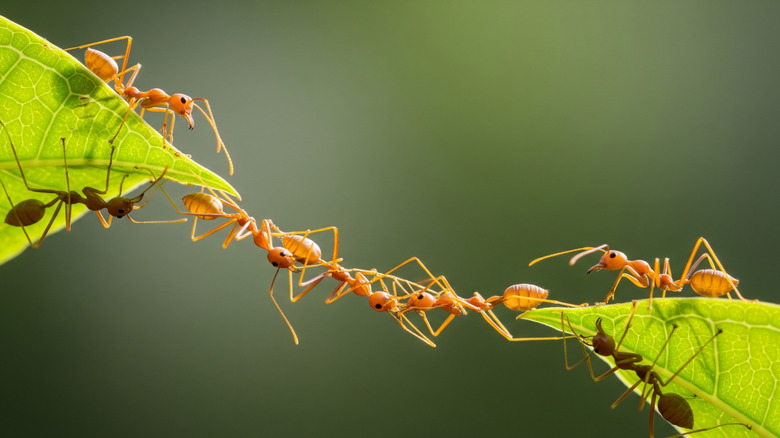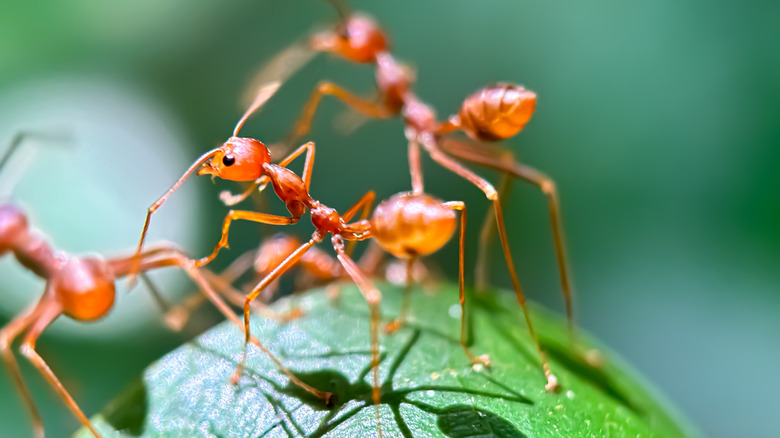How To Identify Weaver Ants And Get Rid Of Them Safely
Few things are more frustrating than unwanted insects making themselves right at home in your otherwise tranquil yard or garden. Pesky insects like ants can damage your plants, weaken trees, and even spread diseases or cause allergic reactions, depending on which species you're dealing with. One ant species that's known to be particularly aggressive is the weaver ant. Unlike fire ants that build anthills or mounds in your yard, weaver ants commonly reside in trees and use their larvae's silk to weave nests out of leaves for a habitat.
The weaver ant's distinct appearance and behavioral patterns make them relatively easy to identify. Weaver ants are a golden red color and can sometimes have bright green markings. Their behavior is also unique and easy to spot, since they frequently form chains and work together to build nests in trees out of leaves. Weaver ants are extremely territorial and can even bite if provoked, so if you identify a weaver ant nest in a tree or plant around your yard, it might be time to take action. They're highly intelligent and can easily make their way into your house if left to their own devices.
Luckily, if you do discover a weaver ant problem in your yard, there are simple steps you can take to eradicate it. Ant colonies can multiply incredibly quickly if not treated in a timely manner, which is why it's crucial not only to resolve the problem but also to take steps to prevent more ants from returning. Here is how you can safely rid your home of a weaver ant infestation and keep them away for good.
How to safely eliminate a weaver ant problem
Once you've identified a weaver ant infestation on your property, you'll want to act quickly before their population continues to increase. To begin, you'll want to prep the surrounding area and cover any exposed skin with long sleeves and gloves that'll keep you protected from poisonous bites. The weaver ant nest is likely in a tree. To discourage the ants from retreating into your home, trim off any tree branches that touch your house or a nearby structure that they could escape to, since they move incredibly fast.
Ultimately, the best way to get rid of the ants is by killing their queen. This can be accomplished by drenching their nest with insecticides or baiting them using ant gel, a poisonous substance that the weaver ants will take back to their nest to share and consume. If you want a more natural method that doesn't use harsh chemicals, you can also spray the weaver ant's nest with a solution of soap and water multiple times a day to strip them of their waxy coats, which leads to dehydration. Another option is to place tree barriers on the infested tree's trunk with sticky bands that will prevent them from climbing and obstruct their paths.
If the problem is severe, you might want to manually destroy the weaver ant's nest by pruning the infested tree branches and disposing of them, thus destroying the ant's home. It's best to do this during the middle of the night or in the early morning when the ants are asleep inside the nest. These sneaky tricks will help when dealing with ant nests.
Prevententive measures to stop them from coming back
The best way to discourage weaver ant colonies from returning to your yard is to be proactive and take simple preventive measures. An easy way to accomplish this is by regularly pruning your trees to avoid an abundance of overgrown branches. If you're diligent about maintaining your yard, you're more likely to prevent diseases, notice infestations faster before they escalate, and discourage future ant colonies from moving in.
Another factor that can attract weaver ant colonies to your yard is existing pest populations. Weaver ants are the natural predators of many common pests and could be attracted to pests that you already have lurking around your garden or house plants. They're particularly fond of aphids and the sugary sap-like substance they secrete called honeydew. Weaver ants feed on aphids' honeydew and they could be encouraged to call your yard home if you leave aphid infestations untreated.
There is also a simple solution to keeping ants out of your home. Removing any leaves, branches, or debris that's physically touching your house can discourage weaver ant colonies from building nests nearby or invading your home's interior. Weaver ants are small enough to slip inside through cracks, doors, or windows, so discouraging them from building nests on or around your home's structure is important. If you do find yourself with a weaver ant infestation, it's important to remember that there are several solutions and steps you can take to get your yard back to being insect-free, and the quicker you take action, the easier it will be in the long run.


